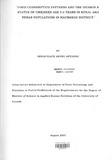| dc.description.abstract | This study was undertaken between March and May 2003 to determine the
food consumption patterns and the vitamin A status of children 2-6 years of
- age in a rural setting compared to those in an urban setting in Machakos
district of Kenya. The study was cross-sectional in nature. Two divisions
were purposively sampled namely Kalama and Central representing rural
and urban settings respectively. Data on demographic and socio-economic
characteristics of the population, knowledge on vitamin A, morbidity
patterns and food frequency was collected using previously pre-tested
questionnaires.
Results showed that a diversity of food items was consumed in the two
divisions, some more frequently than others. The most frequently consumed
foods were cow's milk, papaws, pumpkins, spinach and kales, which were
consumed at least daily in Kalama by 82.5%, 38.8%, 54.4% and 42.2%
respectively. In Central, the children consumed cows' milk, and
spinach/kales at 97.5% and 171.5%respectively. Chi-squire test showed
significant difference (P<0.05) in the consumption of cow's milk and
spinach/kales between the divisions. Fats and oils were consumed in
Kalama by 96.9% and in Central by 100% and there were no statistical
significant differences among the level of consumption.
Clinical examination showed that 4.4% of the children in Kalama division
and 6.8% in Central division suffered from severe vitamin A deficiency.
Prevalence of night-blindness in Kalama was 1.9% and Bitot's spots 3.2%. In
Central, night blindness and Bitot's sports were found to have equal
prevalence at 4.1%. The prevalence of vitamin A deficiency was numerically
higher in males than in females in Kalama division, at 4.5% and 2.5%
respectively but this difference was not statistically significant.
Consumption of vitamin A rich foods was very low except for milk, which
was reportedly consumed by more than 50% of the children at least once to
many times in a day in both divisions. There was little difference between
rural and urban populations in terms of their consumption of vitamin A rich
foods from animal origin. The major difference was noted in the
consumption of green leafy vegetables like Amaranth and pumpkin leaves
which was much higher in the rural than in the urban division (P<0.05).
There were no statistically significant differences in consumption patterns
and vitamin A status of the children.
The study established that the prevalence of VAD is of public health
significance in both the rural and urban areas of Machakos district studied
in Kenya. The prevalence of severe forms of VAD;night blindness and Bitot's
spots were above the WHOcut off points. | en |

